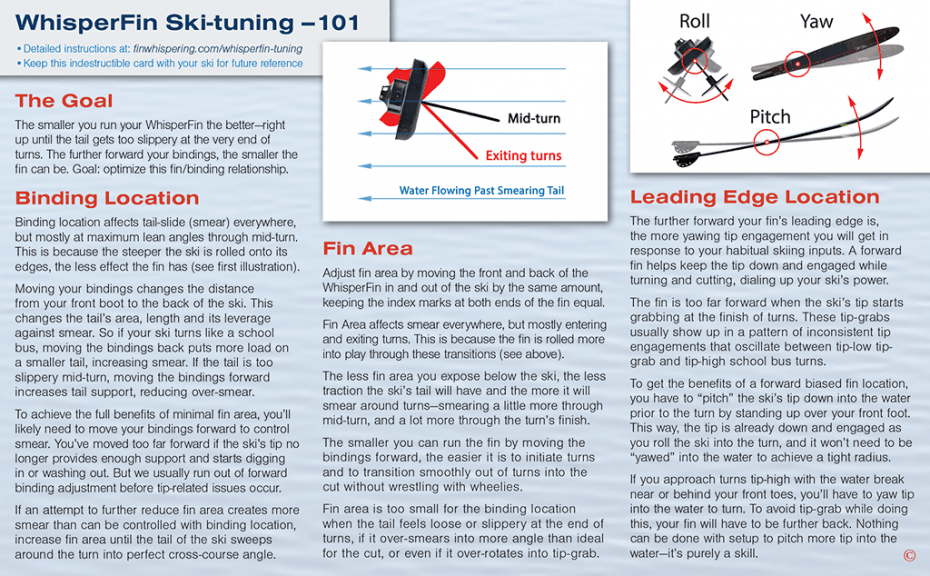Familiarity with the following fundamental concepts is essential to your understanding of ski-tuning.
The Goal
The smaller you run your WhisperFin the better—right up until the tail gets too slippery at the end of turns. And the further forward your bindings are, the smaller the fin can be.
The goal is to optimize this small-fin bindings-forward relationship.
Binding Location
Binding location affects tail-slide (smear) everywhere, but mostly at maximum lean angles through mid-turn. This is because the steeper the ski is rolled onto its edges, the less effect the fin has.

Moving your bindings changes the distance from your front boot to the back of the ski. This changes the tail’s area and its length or leverage against smear. So if your ski turns like a school bus, moving the bindings back makes a smaller tail carry more load, increasing smear. If the tail is too slippery at max lean angles, moving the bindings forward reduces this high-roll over-smear by increasing tail area, leverage, and support.
To achieve the full benefits of minimal fin area, you’ll likely need to move your bindings forward to control smear. You’ve moved too far forward if the ski’s tip no longer provides enough support and starts washing out. Don’t be surprised if you run out of forward binding adjustment before any noticeable tip-related issues occur.
If an attempt to further reduce fin area creates more smear than can be controlled with a forward binding move, increase fin area until the tail of the ski sweeps around turns into perfect cross-course angle.
Fin Area
Fin Area affects smear everywhere, but mostly entering and exiting turns because the ski is rolled flatter there, bringing the fin more into play.
The less fin area you expose below the ski, the less traction the ski’s tail will have and the more the tail will slide around turns—smearing a little more through mid-turn, and a lot more through the turn’s finish.
The smaller you run the fin by moving the bindings forward, the easier it is to initiate turns and to transition smoothly out of turns into the cut without wrestling with wheelies.
Fin area is too small for the binding location when:
- the tail feels loose or slippery at the end of turns,
- the tail over-smears past a sustainable angle for the cut and requires a directional correction, or
- if the tail over-smears into form-crushing tip-grabs.
Fin area adjustments have two steps:
- Moving the fin in or out of the ski while keeping the index marks at the front and back equal.
- Moving the fin forward or back to return the fin’s leading edge location (LE) to where it was prior to step one.
Here’s an example of reducing fin area—without a caliper. Turn the two top set screws ¼ turn counterclockwise, then move the fin forward by a ¼ turn clockwise of the DFT set screw. This DFT adjustment restores LE and keeps your tip behavior constant while reducing tail grip.
Leading Edge Location (LE)
The further forward the fin’s leading edge is set, the easier it is to rotate/yaw tip into the water and keep it down through the finish of turns and for powerful acceleration. The further back LE is, the more the tip resists being rotated into the water, guarding against tip-grabs—helpful for skiers who tend to arrive at turns tip-high before yawing the tip into the water to turn. This setting varies widely depending on skier technique. So to optimize it for your technique, set the fin as far forward as possible without causing tip-grab.


Moving the fin back and forth to adjust yawing tip-engagement also changes the distance between the skier’s bindings and the fin, giving the fin more or less leverage against smear. So if you move the fin far enough, you may need to compensate for the change to this leverage with a small fin area adjustment. But DFT changes smear so little that a full 360° turn of the DFT setscrew would only need a ⅛ turn of FL and FD to compensate for this smear change.
For example, if you move your fin forward by a 360° clockwise turn to DFT (≈.045″), then FL and FD could be increased by a ⅛ turn clockwise (≈.005″) each (keeping the fore and aft index marks equal) to restore smear to its previous level. Moving the fin forward this much is a lot. So in practice, LE changes can be done without any fin area compensation.


